Consumers in 2023 know too well that technology comes and goes. As we wave “goodbye” to the blockchain, along comes generative AI – and who knows what’s around the next corner?
We’re not the first to wonder how tech changes with time. The technology life cycle (or TLC) was developed in the twentieth century to understand the coming and going of technological innovations.
This article will introduce the idea of the technology life cycle. it will
- Provide a clear definition of the concept, with a worked example
- Show some of the major use cases
- Mention a few criticisms of the model
- Evaluate a handful of alternative models.
There are many ways to think about the latest digital trends – surveys, speculation, or investigative reporting. The technology lifecycle gives us another valuable tool: these insights are essential for anyone planning a digital transformation project.
Just a quick warning: the TLC is a massive concept. Researchers, business leaders, and commentators are constantly exploring its meaning. This article can’t explain everything, but it gets you started.
What is the technology life cycle?
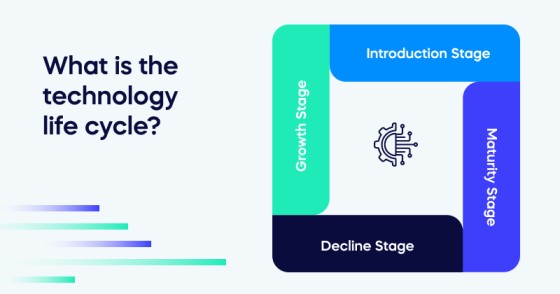
The technology life cycle refers to the stages a technology goes through, from its initial development to its eventual obsolescence. It provides a framework for understanding a technology’s adoption, growth, maturity, and decline over time. The concept of the technology life cycle is often used to analyze the dynamics and evolution of technologies in various industries and markets.
The idea of the technology life cycle is not new. It was first created after the industrial revolution. By that time, the world had seen new ideas rise and fall. As time has moved on since then, technology’s conception, implementation, and decay have only become more rapid.
There are many different models of the technology life cycle. One meta-analysis has shown that they often include very different types of stages. But here are four that are often mentioned.
Introduction Stage
This is the early phase of a technology’s life cycle when it is first introduced to the market. Limited adoption, high costs, and uncertainties during this stage often characterize the technology. Innovators and early adopters are typically the primary users, and the market potential is not yet fully realized.
Growth Stage
In the growth stage, the technology experiences rapid adoption and market expansion. It gains traction as more users adopt the technology, and there is increasing demand for related products and services. Improvements in functionality, affordability, and user experience contribute to widespread adoption and market growth.
Maturity Stage
The maturity stage represents a period of market stability and saturation. The technology has achieved widespread adoption, and the market has become more competitive. Incremental improvements and enhancements are made during this stage, but major breakthroughs or disruptions are less common. Market consolidation and price competition are often observed.
Decline Stage
In the decline stage, the technology’s market share diminishes as it becomes outdated or replaced by newer technologies. Factors such as changing user preferences, technological advancements, or disruptive innovations contribute to the decline. Organizations may phase out production, and users focus on newer and more advanced alternatives.
The technology life cycle in action: An example
From the point of view of 2023, we can now look back on 50 years of technological innovation, implementation, change, and decay.
To explain how the technology life cycle works, let’s explore how PCs fit into this framework. Fifty years ago, imagining computers outside major businesses and research institutions would have been impossible. Now, PCs are still on the scene. But in many use cases, they’ve been supplanted by various other solutions.
Personal Computers (PCs) are an excellent example of a technology that has followed the technology life cycle. Let’s see how they work.
Introduction Stage. The introduction stage marked the birth of personal computers. In the 1970s and early 1980s, PCs were introduced as a new technology that hobbyists and tech enthusiasts primarily used. They had limited functionality and were not widely adopted.
Growth Stage. During the 1980s and 1990s, personal computers experienced rapid growth and became more accessible to consumers and businesses. Advancements in hardware and software and the rise of graphical user interfaces (GUIs) and productivity applications contributed to the widespread adoption of PCs. This period witnessed increasing sales, expanding user bases, and a growing market.
Maturity Stage. Personal computers entered the maturity stage by the late 1990s and early 2000s. PCs became a ubiquitous tool for individuals, businesses, and educational institutions. The market became saturated, and competition intensified. Incremental improvements characterized this stage, such as faster processors, increased storage capacity, and improved connectivity.
Decline Stage. In recent years, the personal computer market has experienced a decline due to several factors. The rise of mobile devices, such as smartphones and tablets, led to a shift in consumer preferences and computing habits. Many users started relying on mobile devices for everyday tasks, which affected PC sales. However, it’s important to note that PCs still hold significance for specific use cases, such as content creation, gaming, and professional work.
The technology life cycle of personal computers illustrates the trajectory from their introduction as a niche technology to their widespread adoption and eventual market saturation. While the traditional desktop PC market has declined, the industry has adapted by diversifying its offerings and catering to specific user demands. PCs continue to evolve and find relevance in various professional and niche markets, ensuring their ongoing presence alongside other computing devices.
Use cases for the technology life cycle model
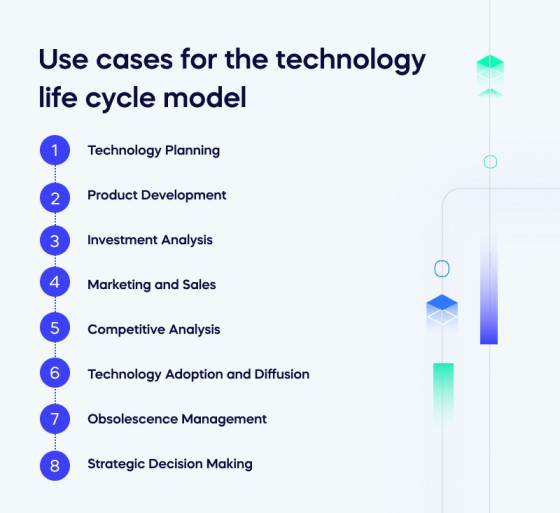
So – why would anyone want you to use a version of the technology life cycle? The reality is that it’s a great way to make advanced business decisions. In this article, we don’t have the space to examine every use case. To give you a taste of the many applications of this model, here are brief introductions to some of the principal values.
- Technology Planning: Aligning investment and resource allocation based on the anticipated stages of a technology’s life cycle.
- Product Development: Timing product launches and targeting market segments based on the life cycle stage of the technology.
- Investment Analysis: Evaluating potential returns and risks associated with investing in a particular technology.
- Marketing and Sales: Tailoring messaging and positioning strategies according to the characteristics of each life cycle stage.
- Competitive Analysis: Identifying potential disruptions, shifts in market share, and emerging technologies that may impact the business.
- Technology Adoption and Diffusion: Understanding factors influencing digital adoption rates, barriers, and the role of early adopters and Laggards.
- Obsolescence Management: Determining when to phase out outdated technologies and plan for replacements or upgrades.
- Strategic Decision Making: Making informed decisions regarding innovation, partnerships, acquisitions, and diversification based on the technology life cycle.
Criticisms of the technology life cycle model
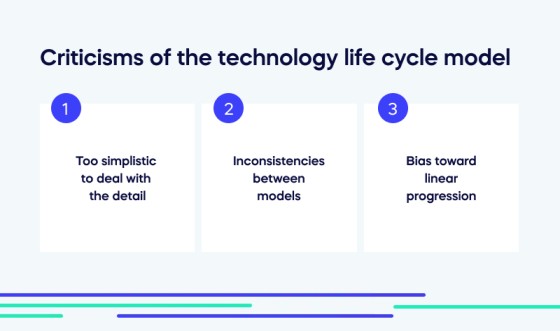
Although the technology life cycle is useful for understanding how technology works, it is not an absolute truth. Like any cultural analysis, it’s a faulty human method for making sense of the world.
So it’s no surprise that there are plenty of criticisms of the TLC way of thinking.
Too simplistic to deal with the detail
It does not helpfully distinguish between different levels of detail. Are we looking at a specific product – a category of product – or the satisfaction of a particular goal? Most TLC models can’t handle this kind of differentiation.
More generally, the different versions of the TLC oversimplify the complex dynamics of technology adoption and evolution. It fails to capture the nuances and unique characteristics of different technologies and industries, leading to a generalized understanding that may not apply universally.
Inconsistencies between models
The technology life cycle is not just one model. If only! There are so many variations that it would be more accurate to talk about technology life cycles.
That variation is not so important for academic researchers and theorists. But comparability is essential for anyone trying to make decisions for their company. Synchronizing data between different models can take a lot of unnecessary effort.
Bias toward linear progression
In most forms, the technology life cycle assumes a linear progression from the innovation stage to its decline phase, suggesting that technologies inevitably become obsolete. However, this perspective ignores cases where technologies may experience cycles of resurgence or transformation, adapting to new market demands or merging with other technologies to create new possibilities.
Alternatives to the technology life cycle
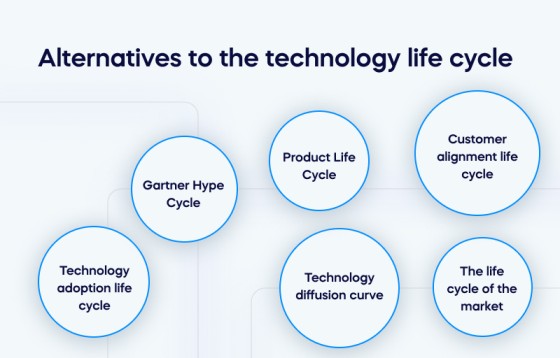
The “technology life cycle” models are useful for some things but not for everything. This final section examines alternative ways of thinking about technology innovation, adoption, and decline. We’ll look at –
- Gartner Hype Cycle
- Product Life Cycle
- Technology adoption life cycle
- Customer alignment life cycle
- Technology diffusion curve
- The life cycle of the market
These alternative product cycle models offer different perspectives on technology or product adoption, development, and market dynamics.
The Gartner Hype cycle
The Gartner Hype Cycle model visualizes the maturity, adoption, and hype surrounding a technology. It represents the stages of technology hype, such as the “innovation trigger,” “peak of inflated expectations,” “trough of disillusionment,” and “plateau of productivity,” providing insights into the potential risks and benefits associated with technology.
The hype cycle helps to explain the craze around Generative AI: for example, in generative CRM. Only time will tell whether this is a genuinely useful technology in the long term.
Product Life Cycle
The product life cycle model focuses on the stages a product goes through, from its introduction to its eventual decline. It includes the introduction, growth, maturity, and decline stages, providing a framework for understanding the product’s market acceptance, sales growth, and eventual saturation or obsolescence.
Technology Adoption life cycle
The Technology Adoption Life Cycle model describes the adoption patterns of new technologies among different user groups. It identifies five categories of adopters—innovators, early adopters, early majority, late majority, and laggards—and illustrates how technology adoption progresses from the early enthusiasts to more mainstream users over time.
The Customer Alignment Lifecycle.
The Customer Alignment Lifecycle model focuses on the customer’s journey with a product or service. It emphasizes the importance of understanding and aligning with customer needs and expectations at each lifecycle stage, from awareness and consideration to purchase, usage, and loyalty.
Technology Development cycle
The Technology Development Cycle model outlines the technology development stages, from research and prototyping to commercialization. It encompasses activities such as ideation, feasibility assessment, design, testing, and production, providing a framework for managing the process of developing and bringing a technology to market.
Product diffusion curve
The Product Diffusion Curve illustrates a product’s adoption rate across the market. It showcases the different adopter categories and maps the percentage of the population that has adopted the product over time, highlighting the early adopters, early majority, late majority, and laggards. The life cycle of the market
The Life Cycle of the Market model focuses on the stages of a market’s development. It considers the market’s growth, maturity, saturation, and decline, providing insights into the market’s dynamics and the need for companies to adapt their strategies as the market evolves.
Technology life cycle: You might need a DAP
As we’ve seen, the Technology Life Cycle represents one way of thinking about the problem. It is not an absolute truth about the universe. It can be a useful way to think about the impact of technology on your company or the result of your product on others.
This article has explained how the technological life cycle tracks technological phenomena’ emergence, development, and decay. Although it has numerous applications in business, the model has flaws, and alternative options are available.
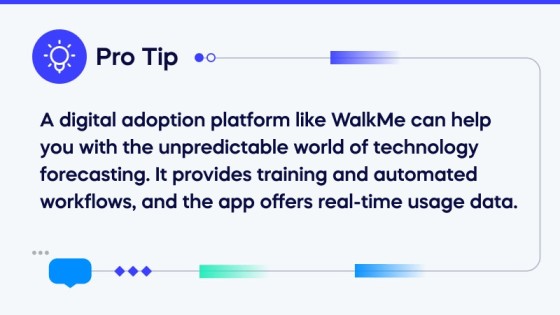
A digital adoption platform like WalkMe can help you with the unpredictable world of technology forecasting. It provides training and automated workflows, and the app offers real-time usage data. Combined with a long-term model of technological change, your technology management systems will be a force to be reckoned with.

Frequently Asked Questions
Enterprises can extend the maturity phase by implementing incremental innovations, enhancing user experience, and exploring new markets or applications. These actions help sustain competitiveness and delay the onset of decline.
Understanding the technology life cycle aids in timing investments, allocating resources effectively, and assessing risks. Investing during the growth phase may yield higher returns, while caution is advised during the decline phase
Intellectual property rights, such as patents, can protect innovations during the early stages, providing a competitive edge and potentially extending the profitability period of a technology.
Organizations should plan for technology retirement by identifying successors, reallocating resources, and ensuring smooth transitions to newer technologies to maintain operational efficiency
Differentiating the two helps in strategic planning; the technology life cycle focuses on the evolution of the underlying technology, while the product life cycle pertains to the market performance of a specific product utilizing that technology.

